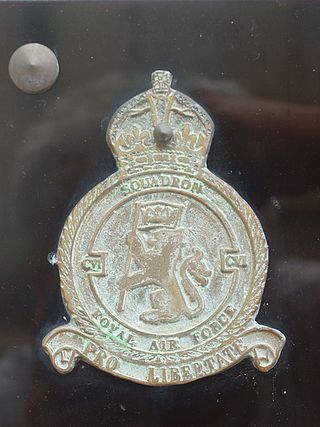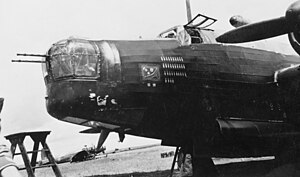
No. 220 Squadron of the Royal Air Force (RAF) was founded in 1918 and disbanded in 1963 after four separate periods of service. The squadron saw service in both the First and Second World Wars, as a maritime patrol unit, and finally as part of Britain's strategic nuclear deterrent.
Royal Air Force Filton or more simply RAF Filton is a former Royal Flying Corps (RFC) and Royal Air Force (RAF) station located 5 miles (8 km) north of the city centre of Bristol, England.

No. 102 Squadron was a Royal Air Force night bomber squadron in the First World War and a heavy bomber squadron in the Second World War. After the war it flew briefly as a transport squadron before being reformed a light bomber unit with the Second Tactical Air Force within RAF Germany. Its last existence was as a Thor strategic missile unit.

No. 266 (Rhodesia) Squadron RAF was a squadron of the Royal Air Force.

No. 97 Squadron, was a Royal Air Force squadron formed on 1 December 1917 at Waddington, Lincolnshire.

No. 106 Squadron RAF was a Royal Flying Corps and Royal Air Force squadron active from 1917 until 1919, throughout World War II and during the Cold War from 1959 until 1963.
No. 113 Squadron began service in 1917 with the Egyptian Expeditionary Force commanded by General Edmund Allenby. Initially, the squadron was a unit of the Royal Flying Corps, serving during the Sinai and Palestine Campaign and as a reconnaissance, army cooperation, bomber, fighter, transport and missile operation squadron during its existence.

Royal Air Force Coleby Grange or more simply RAF Coleby Grange was a Royal Air Force satellite station situated alongside the western edge of the A15 on open heathland between the villages of Coleby and Nocton Heath and lying 7.4 mi (11.9 km) due south of the county town Lincoln, Lincolnshire, England.

No. 112 Squadron was a squadron of the Royal Air Force. It served in both the First World War and Second World War and was active for three periods during the Cold War. It is nicknamed "The Shark Squadron", an allusion to the fact that it was the first unit from any Allied air force to use the famous "shark mouth" logo on Curtiss P-40s.

No. 104 Squadron RAF is a former squadron of the British Royal Air Force.

Royal Air Force Graveley or more simply RAF Graveley is a former Royal Air Force station located 5 miles (8 km) south of Huntingdon. The station was originally intended to operate under No. 3 Group RAF, alongside RAF Tempsford and RAF Gransden Lodge.

No. 223 Squadron RAF was a squadron of the Royal Air Force. Originally formed as part of the Royal Naval Air Service (RNAS), the Squadron flew in both World Wars.

No. 103 Squadron was a Royal Air Force bomber squadron during World War I, World War II and the Cold War, switching to helicopters in the late 1950s until it was disbanded for the last time in 1975.
No. 82 Squadron RAF was a Royal Air Force squadron that was first formed in 1917 and last disbanded in 1963. It served at times as a bomber unit, a reconnaissance unit and lastly as an Intermediate Range Ballistic Missile (IRBM) unit.
Air Headquarters East Africa was a command of the British Royal Air Force (RAF) formed on 19 October 1940 by expanding AHQ RAF Nairobi. On 15 December 1941, the command was reduced to Group status as No. 207 Group. On 16 November 1942, Air H.Q. East Africa was reformed by raising No. 207 Group back to Command status again.
No. 107 Squadron RAF was a Royal Flying Corps bomber unit formed during the First World War. It was reformed in the Royal Air Force during the Second World War and was operational during the Cold War on Thor Intermediate Range Ballistic Missiles.
No. 98 Squadron was a Royal Air Force bomber squadron during World War I and World War II. It flew fighter-bombers post-war, and converted to fighters in 1955. Reformed as a ballistic missile unit between 1959 and 1963, its final incarnation was as a radar calibration unit. It was disbanded in 1976.

No. 226 Squadron RAF was a unit of the British Royal Air Force that existed as a bomber squadron during the First and Second World Wars, and as part of the UK's nuclear ballistic missile force in the early 1960s.
No. 240 Squadron RAF was a Royal Air Force flying boat and seaplane squadron during World War I, World War II and up to 1959. It was then reformed as a strategic missile squadron, serving thus till 1963.

No. 130 Squadron of the Royal Air Force was a Second World War and Cold War fighter squadron, and later a strategic missile squadron.
















